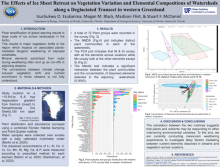The Effects of Ice Sheet Retreat on Vegetation Variation and Elemental Compositions of Watersheds along a Deglaciated Transect in western Greenland.
Izuchukwu
Ezukanma
Department of Biology, University of Florida, Gainesville, Florida, USA.
Poster
An existing underexplored connection is the link between retreating ice sheet due to the Arctic Amplification of global warming, landscape vegetation variations and crustal elemental nutrient composition of watersheds on deglaciated landscape. The warming of the Arctic and retreating icesheet drives plant community changes across the region. Vegetation variations may influence the suites of low molecular weight organic acid available for metal chelation and biogenic weathering of exposed landscapes. Solubilized mineral elements are either taken up by plants or leached into adjoining streams. Plant community change in a warming Arctic could alter downstream nutrient availability on the landscape or watershed. To assess plant species composition and abundance, we used a combination of Floristic Habitat Sampling and modified Point Quarter method to survey plant communities in forty-five 1.25m2 plots across five watersheds in 2022. These locations represent the margins of ~10kya deglaciation gradient. The plant abundance data from the surveys were used to conduct an NMDS analysis which indicates that the species compositions of the study locations were distinct (stress score = 0.15). An ANOSIM test (α = 0.05) analysis indicates the species compositions of the study sites were significantly different (p = 1e -04, R = 04025). The vegetation distribution data was combined with the elemental composition of dissolved nutrient elements (Li, Mg, Al, P, Ca, V, Cr, Mn, Fe, Co, Ni, Cu, Si) from adjoining streams which were analyzed, and the results used to conduct Mantel test (method = Spearman, permutation = 9999). The result indicates a significant (p = 0.0043) interaction between the variables. The correlation between the two matrices suggests that plants and nutrients may be responding to other intervening environmental variables. To this end, we are currently conducting mesocosm weathering experiments to investigate likely factors mediating between nutrient elements dissolved in streams and vegetation across locations.

ezukanma-izuchukwu-polar-poster.pdf
(294.43 KB)
